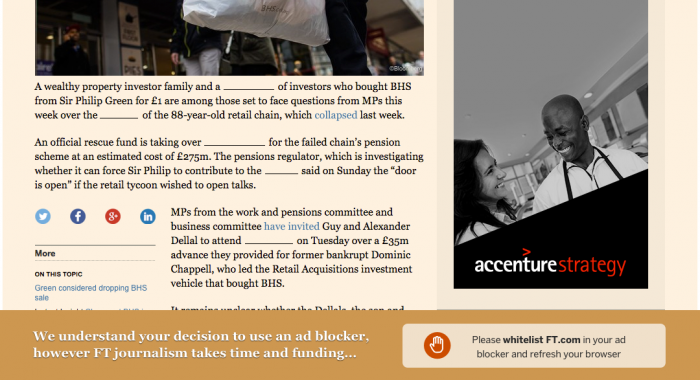
Hope isn’t lost for media organizations trying to get readers to stop blocking their ads. Maybe all they have to do is ask.
In July, The Financial Times ran a 30-day experiment to see what it would take to get people to whitelist the site in their adblocking software. Fifteen thousand of its registered users were split into three groups, each of which had access restricted in different ways. One group, for example, was presented with FT stories that had some of their words removed, a metaphor for the share of revenue that comes from advertising. Other readers weren’t able to access the site at all unless they opted in to ads. Readers were also given a message: “We understand your decision to use an ad blocker. However, FT journalism takes time and funding…”The Financial Times says readers responded well to the experiment. Forty-seven percent of those who had to read stories with missing words agreed to whitelist the site, while 69 percent of users barred from the site entirely agreed to let ads through. And 40 percent of those whose access wasn’t restricted at all opted out of blocking ads.
The experiment shows that, in many case, the most effective anti-adblocking technique is also the most simple: talking directly to readers. The relationship between media organizations and readers online operates via an implicit contract: Publishers offer readers content for free, and in exchange, readers see those publishers’ ads. Making that implicit contract more explicit reminds readers of that dynamic and encourages them to support the sites they read.
Other publishers have tried variations on the idea, erring on the site of politeness and perhaps even repentance. In a recent campaign, Wired acknowledged why its users want to run adblockers (“We get it: ads aren’t what you’re here for) but reminds readers that “ads help us keep the lights on.”Beyond asking people to whitelist, Slate (“We noticed you’re using an ad blocker”) and The New York Times (“The best things in life aren’t free. You currently have an ad blocker installed”) have used the messages to encourage people to sign up for their paid products. The Atlantic has also recently applied this idea.
The success of the efforts “show that FT readers accept advertising as part of the reader/publisher value exchange,” argued Dominic Good, The Financial Times’ global advertising sales and strategy director, in a press release announcing the results of the newspaper’s experiment.
3 comments:
Most news sites have literally zero ethics for what’s considered an “advertisement”, some of these “ads” have cookies and javascript that are dangerous, aka “malware”. If they can’t police their advertisers, then I can’t whitelist their site. Period.
Trackbacks:
Leave a comment
You must be logged in to post a comment.